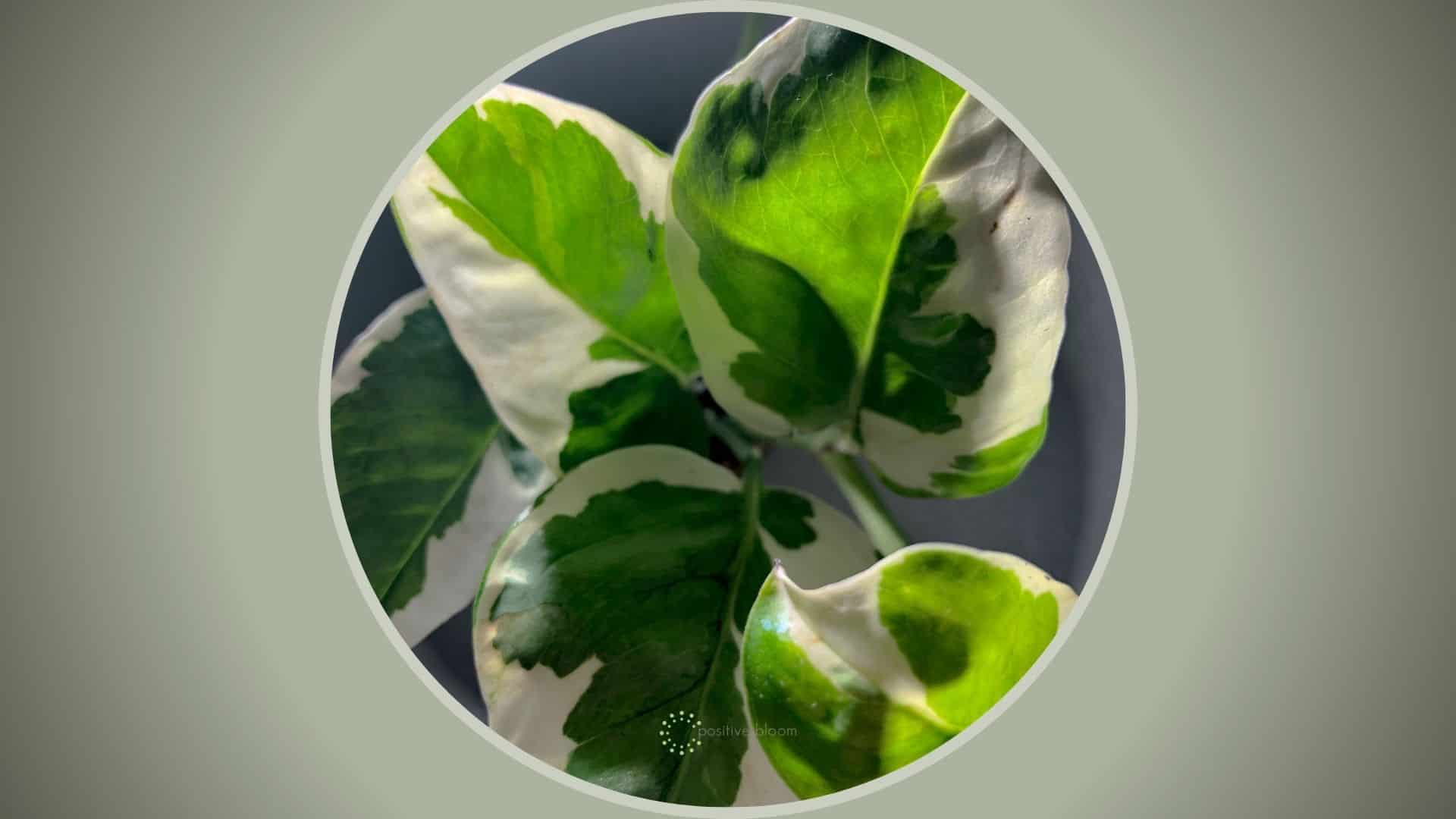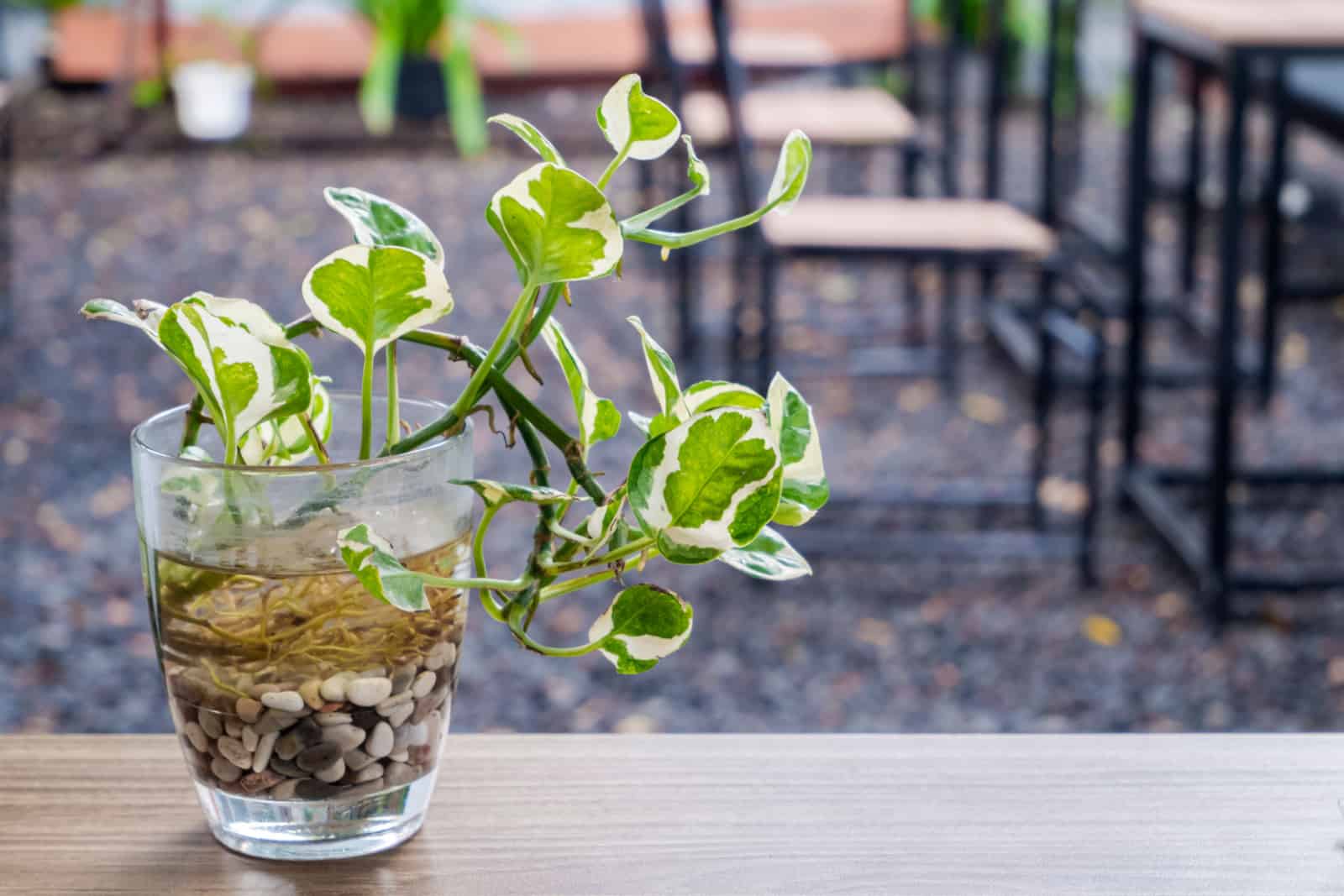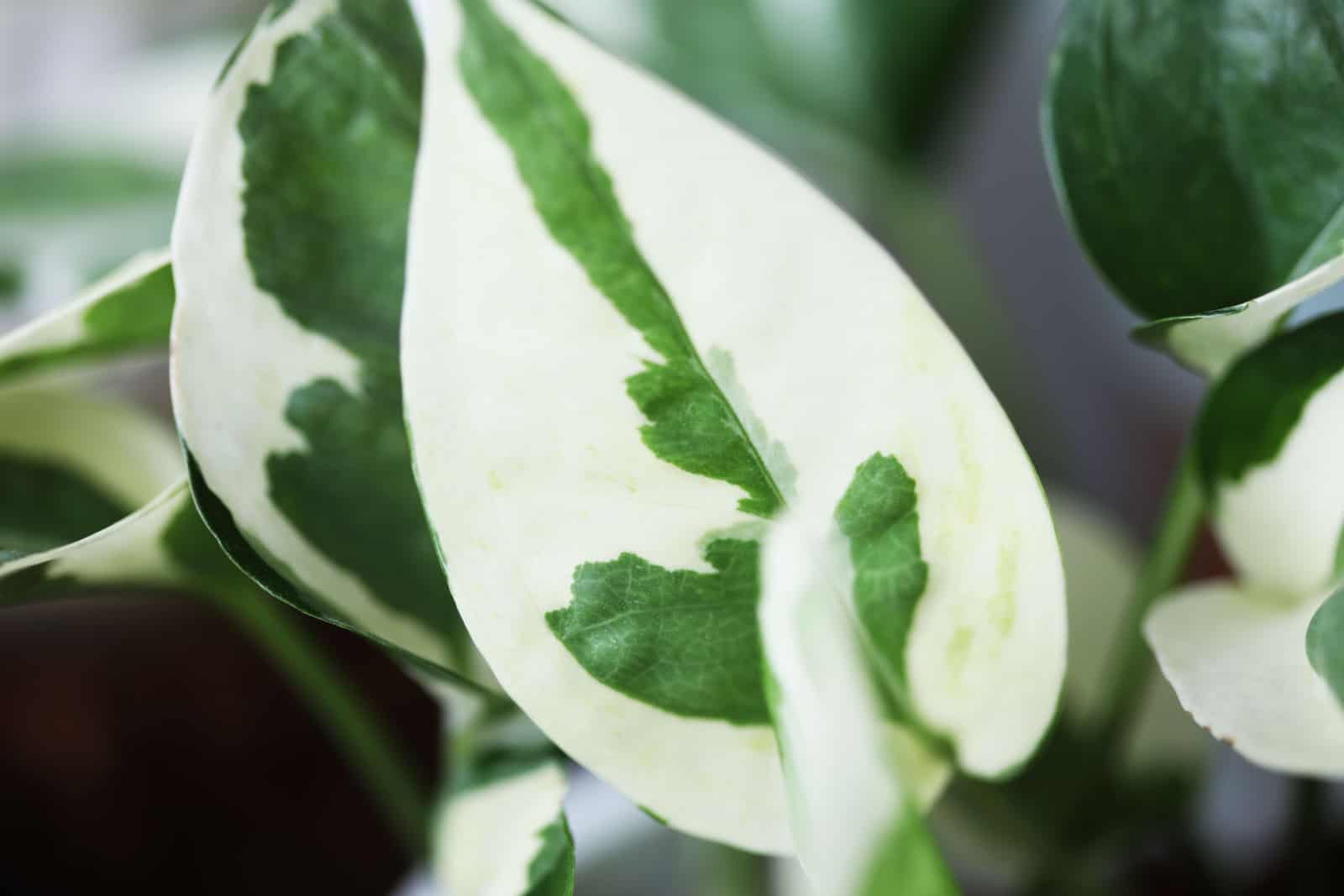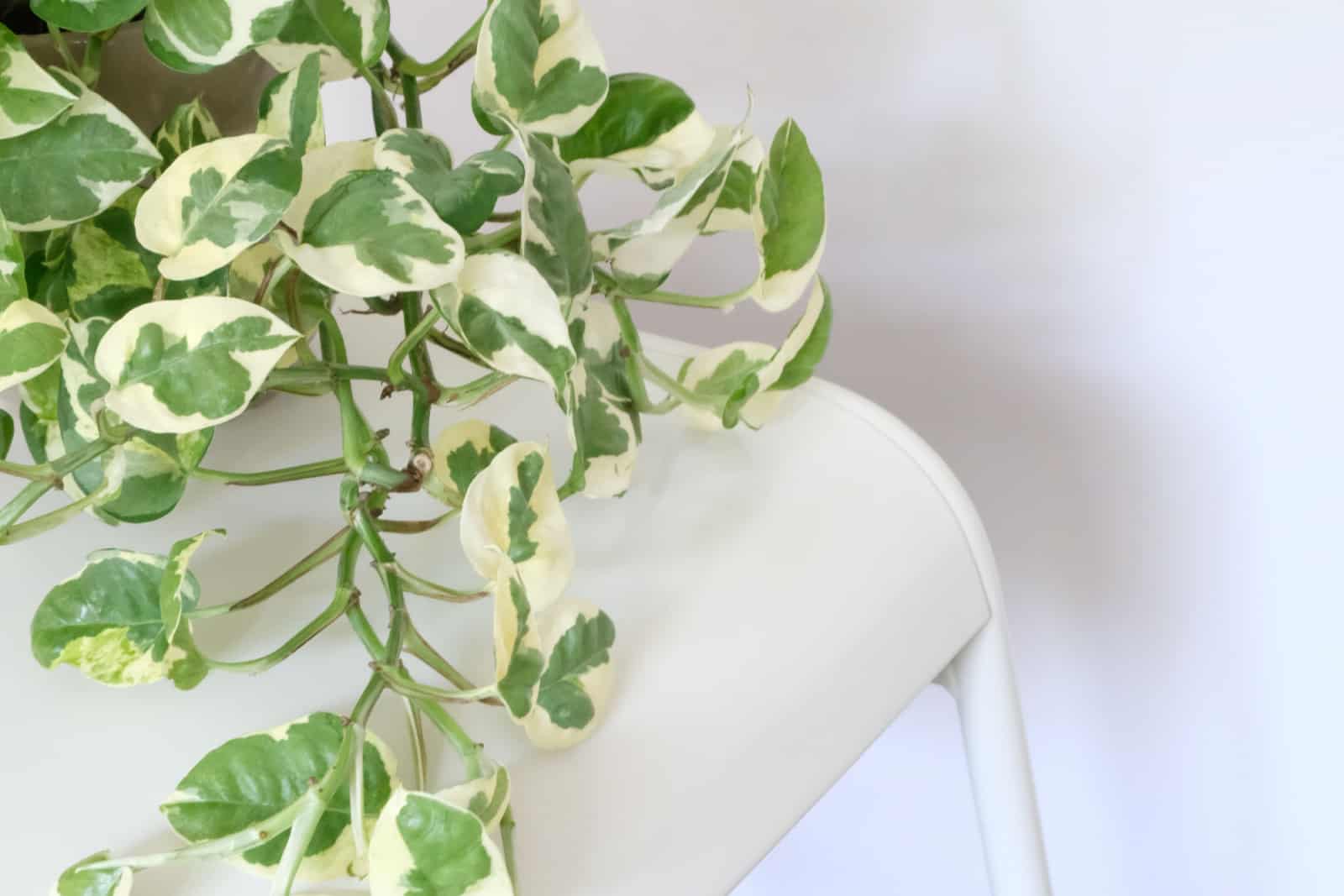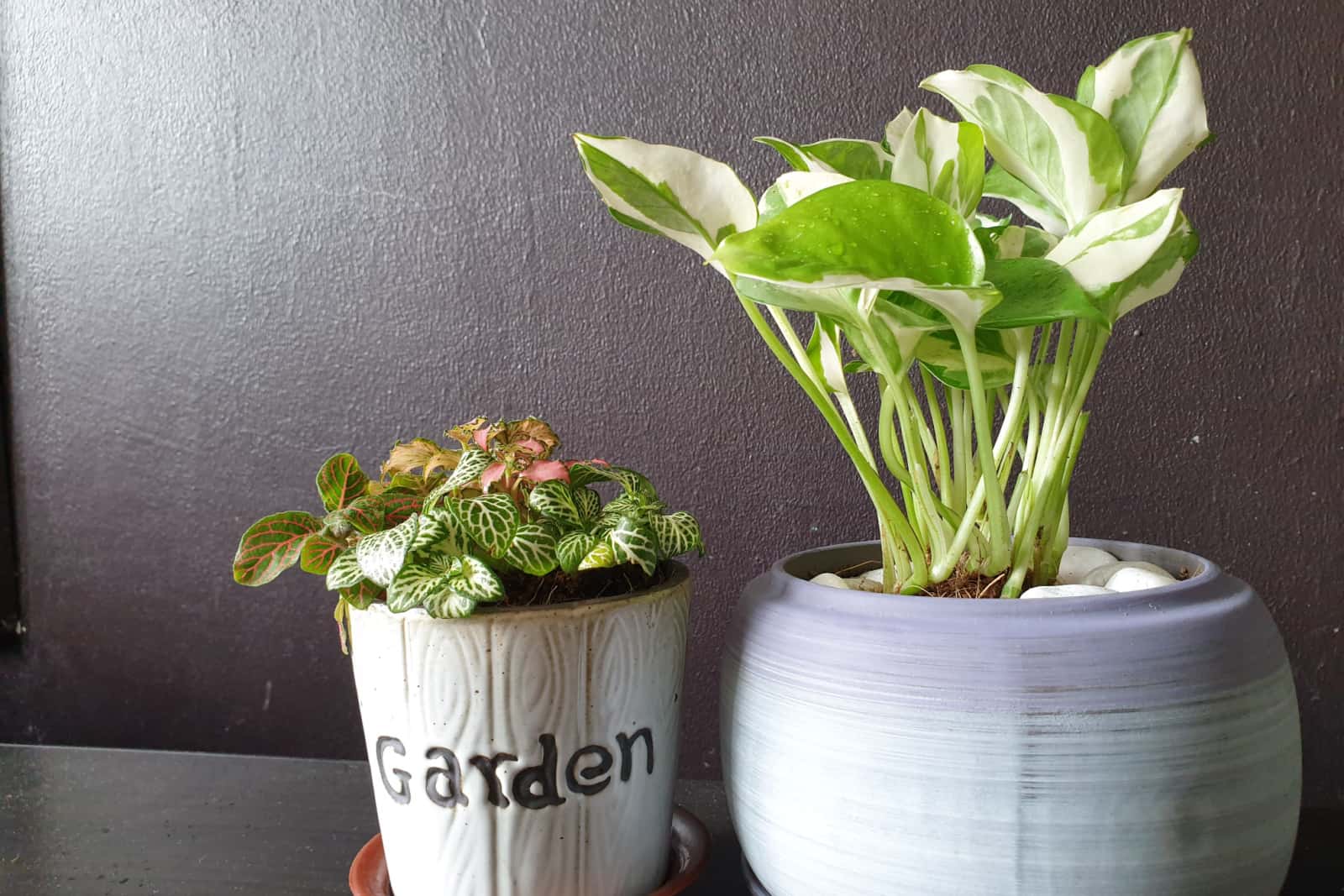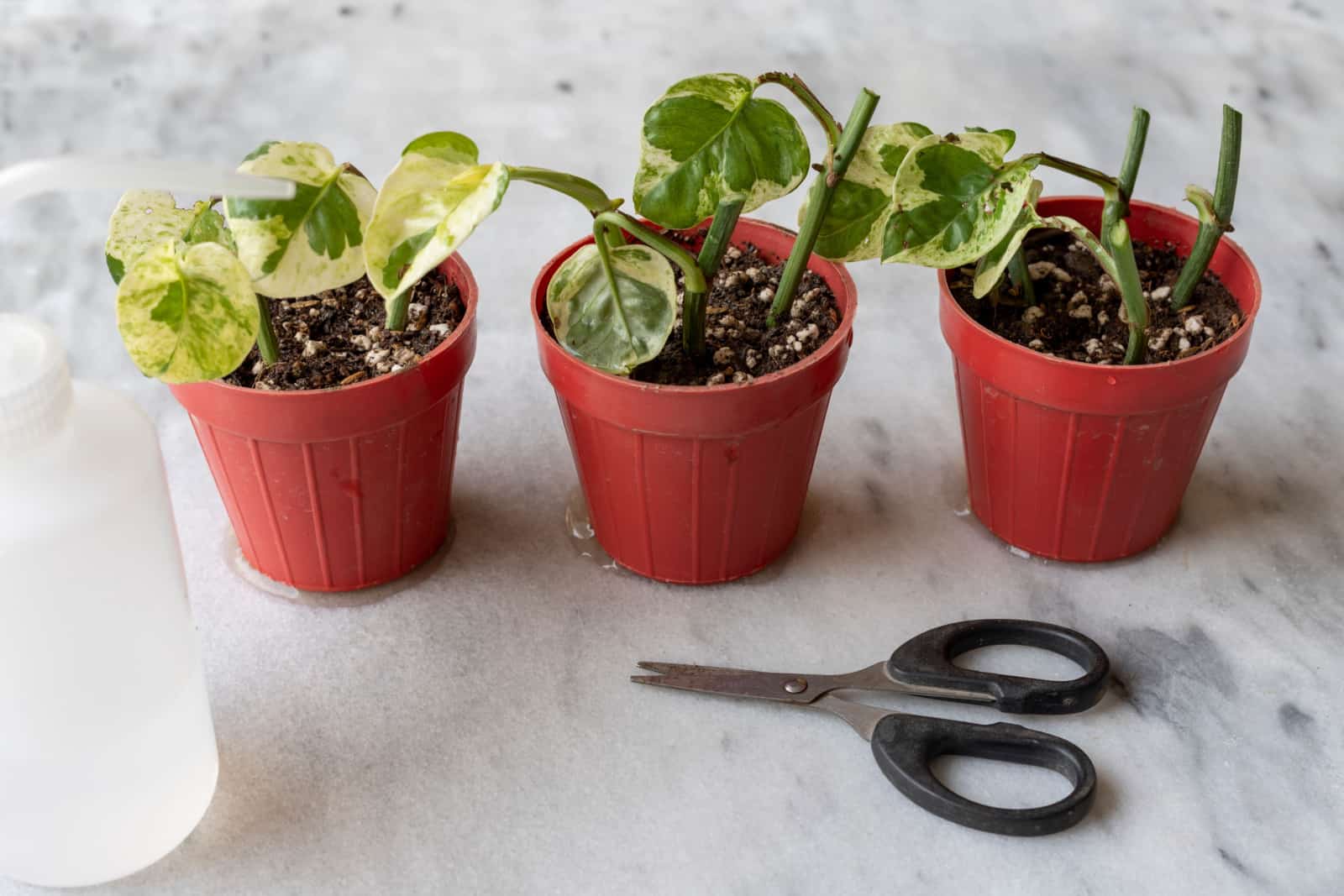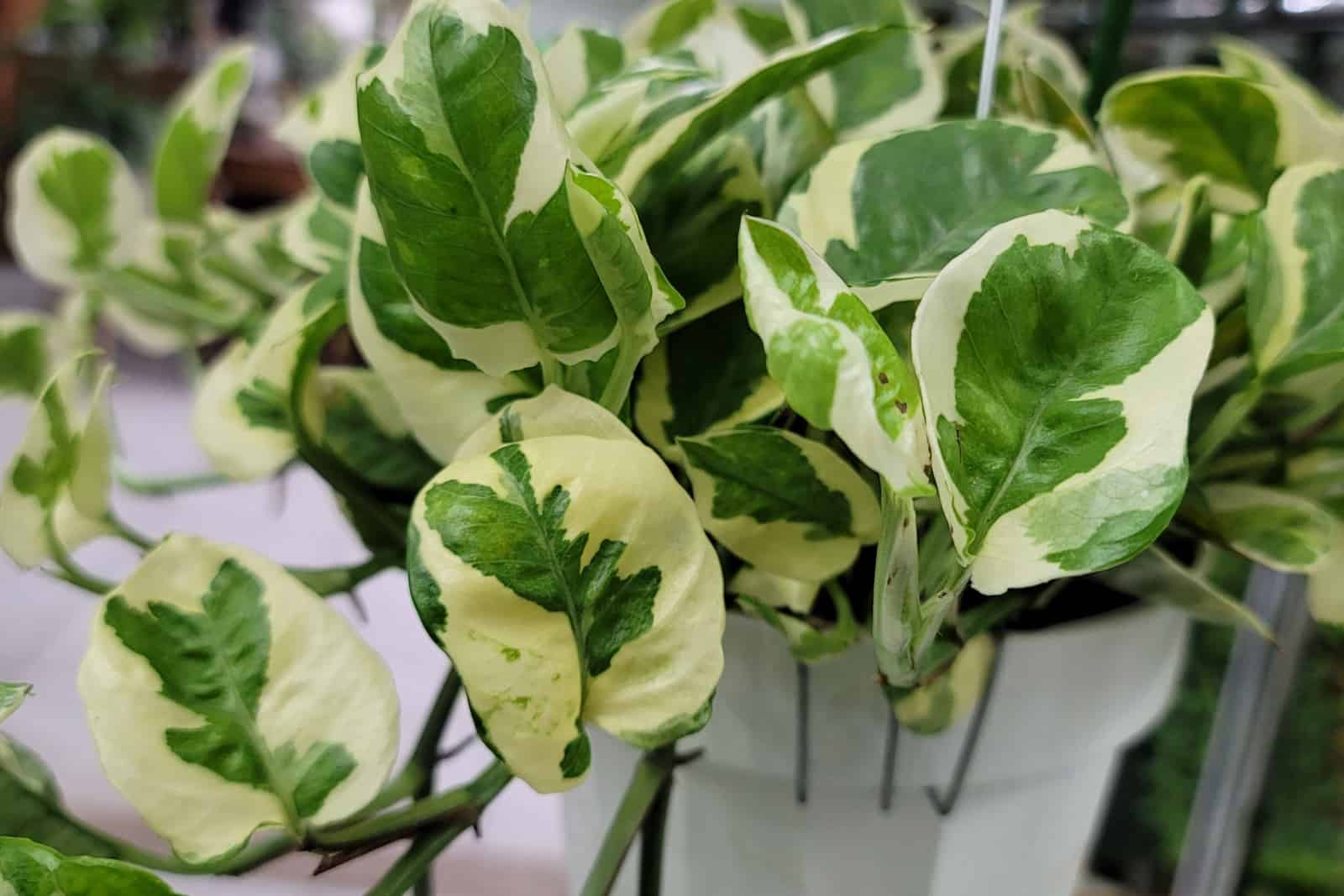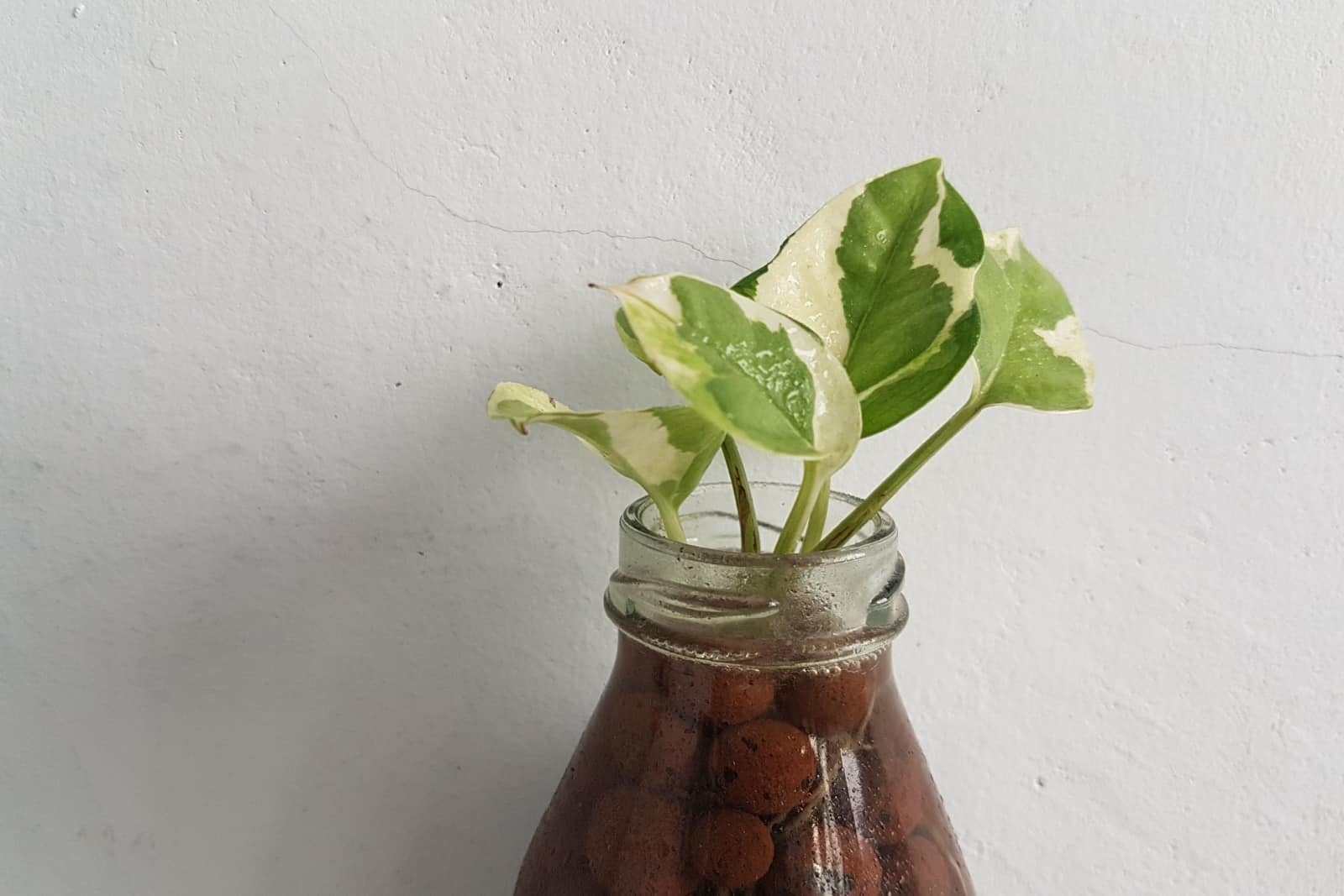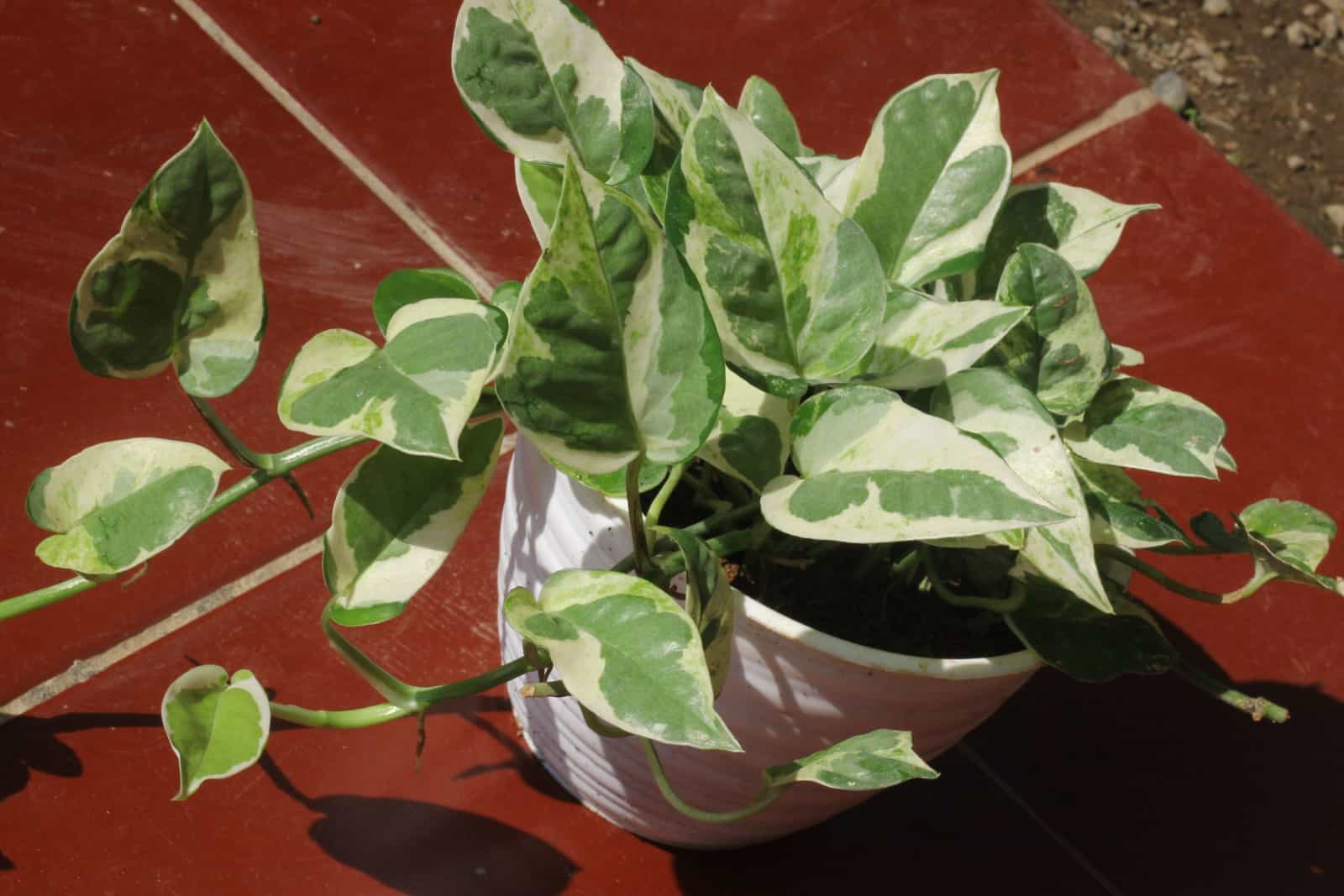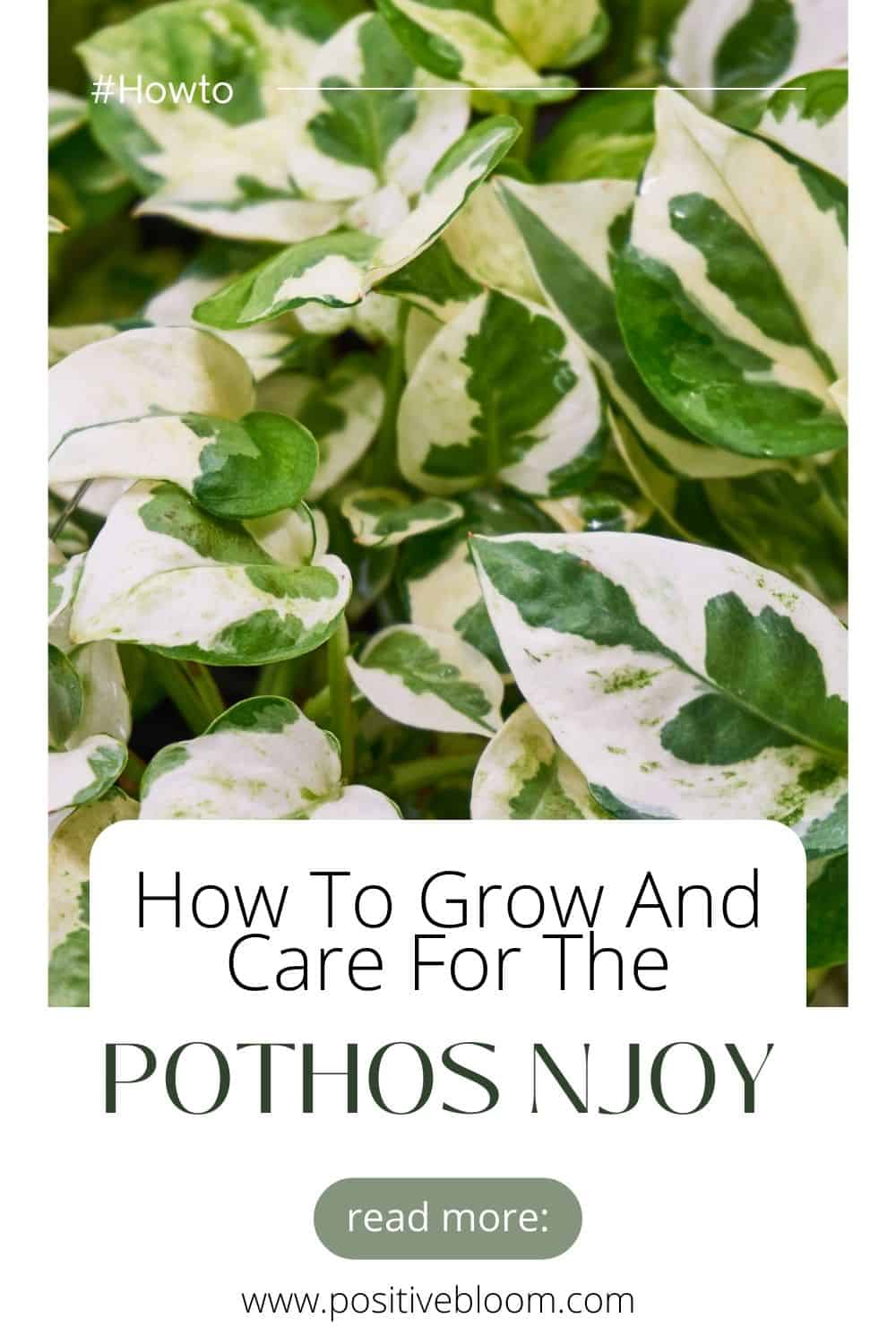When someone mentions pothos plants, we instantly think of Devil’s ivy or Marble queen pothos plants. Well, these are both amazing, but the Epipremnum genus has much more to offer.
In this article, I’ll tell you more about the pothos njoy; a unique cultivar from the Epipremnum genus.
The parent plant of the njoy pothos is the well-known Marble queen pothos.
Just like its cousins, the pothos njoy has low care requirements. You can accentuate its beauty if you grow it in hanging baskets or train it to climb.
I’ll show you its plant features and all the conditions you’ll need to ensure for your njoy plant to thrive. I’ll also show you some excellent ways to propagate it and some problems that can occur.
Let’s start with some basic info about this Epipremnum plant:
| Family: | Araceae |
| Genus: | Epipremnum |
| Scientific name: | Epipremnum aureum Njoy |
| Common names: | Pothos njoy |
| Type of plant: | Climbing vine |
| Native habitat: | Southeastern Asia |
| USDA hardiness zones: | 10-11 |
Let’s take a look at the features first.
What Is The Pothos Njoy?
The Njoy plant belongs to the Epipremnum genus and is a cultivar of the Epipremnum aureum Marble queen.
It’s not an old plant variety, as it first appeared in 2002.
The stunning variegations made growers curious about the plant. Suddenly, everyone wanted it in their plant collection!
What is so special about this pothos plant? I mean, many plant species have variegations, so why is this one different?
Well, each leaf of the njoy pothos plant features white blotches, green and yellow parts, and a little bit of a creamy color.
Mature njoy plants develop heart-shaped leaves that don’t lose color even in winter. That’s one of the best things about evergreen plants!
The leaf shape of pothos and Philodendrons is similar, but these are different plants.
The leaves of this type of pothos are glossy and typically reach 6 inches long. Pothos plants produce flowers, but only in their natural environment. Don’t bother trying to get your njoy plant to bloom, as the leaves are way prettier anyway.
Growth Rate And Habit
Believe it or not, the vines of this Epipremnum plant can reach 10 feet long if provided with adequate care.
But you’ll need to be patient as this lovely plant may take 10 years to reach its mature size.
This pothos has a trailing/climbing growth habit, which means it’ll need structural support for optimal growth.
You can get the desired shape by pruning your njoy plant.
Pothos Njoy vs Pearls and Jade
Njoy Pothos and pearls and jade Pothos are both cultivars of the same plant – the Epipremnum aureum Marble queen.
These two plants are often mistaken due to their resemblance in leaf appearance.
Njoy plants have white variegations, whereas the pearls and jade plant has yellowish, creamy, and green variegations.
The pearls and jade has paperish leaves, and the njoy pothos has a glossy leaf surface with leathery undersides.
Njoy Pothos Care Guide
Just like all other Epipremnum plants, pothos njoy isn’t fussy about conditions, and once you get the gist, you won’t have any problems related to the health of this pothos variety.
The Njoy pothos requires bright indirect light, a porous, fertile, and well-draining growing medium, warm temperatures, moderate to high humidity, and regular feeding.
Let’s get into details!
Light Requirements
All types of pothos, including the Manjula pothos, Hawaiian pothos, and Shangri La pothos, need a lot of bright light to thrive.
The main reason for this is that the leaves need light to preserve their variegations. Plants can’t perform photosynthesis without light, so make sure the light level is correct.
Low light will also cause legginess, and we definitely don’t want that!
You should also avoid exposing your njoy pothos to direct sunlight, as it may cause scorching or sunburns.
If direct light is reaching the plant, shield the njoy pothos leaves by putting sheer curtains on your windows.
On the other hand, if you can’t ensure enough natural light for this Epipremnum aureum plant, use artificial lights instead.
Temperature Requirements
This Marble queen cultivar is native to tropical rainforests, meaning it grows in pretty high temperatures.
The ideal temperature range for the Epipremnum aureum Njoy is from 60 to 80 degrees Fahrenheit.
Regarding the temperature tolerance of this pothos, the lowest you can go is 50 degrees Fahrenheit.
Therefore, this plant has zero tolerance to frost, so if you live in colder climates, growing this pothos outdoors isn’t a good idea.
On the other hand, living in hardiness zones 10 and 11 gives you an opportunity to cultivate these eye-catching plants outdoors.
If you grow this pothos as a houseplant, find a spot where it won’t be exposed to sudden temperature changes or cold drafts.
Humidity Requirements
Epipremnum plants love high humidity, and the njoy isn’t an exception. Keeping humidity over 50% is the best way to encourage healthy growth and avoid issues.
Many growers, especially novices, struggle with keeping the correct humidity levels for indoor plants. Of course, this refers to plants that require higher levels of humidity.
Fortunately, there are several excellent ways to increase humidity for your njoy pothos plant.
Pebble/Humidity Tray Method
Do humidity/pebble trays really increase humidity? Well, if you don’t need to increase humidity much, then the pebble tray method is perfect for you.
All you need is a shallow dish, water, and some pebbles or gravel. Put the pebbles or gravel in the dish, add water, and place your pothos n’joy on top of it.
As I said, it won’t increase humidity much, but it can definitely help, especially if combined with the DIY methods listed below.
What I really like about pebble trays is how they add more beauty to home decor.
Microclimate
How on earth can we create a microclimate? Even though it may not seem like it, this is actually a straightforward way to give your njoy pothos the humidity levels it needs.
All you need to do is group your houseplants; put your pothos n’joy near other indoor plants, such as golden pothos or Philodendrons.
Water will evaporate from the growing media of grouped plants and increase humidity via a process known as transpiration.
Bathroom/Kitchen
If you have the correct light conditions in your bathroom or kitchen, placing your pothos n’joy in one of these rooms will ensure the humidity levels it needs.
I don’t even have to mention how beautiful your kitchen or bathroom will look if you add an njoy pothos!
Misting
Misting is one of the most famous methods for raising humidity. Pour distilled water into a spray bottle and mist your pothos n’joy every couple of days.
Make sure the water from the leaves dries out, as wet leaves attract fungus that could cause rotting.
Humidifier
Beginner growers typically don’t experiment with DIY methods for raising humidity. A humidifier is the best way to increase and monitor humidity for your pothos n’joy plant.
The price is its only drawback, but it is worth every penny in my opinion!
Ideal Soil Type
Regarding potting medium, the njoy pothos has a few criteria. First, the soil mix has to be well-draining, as excess water in the soil can cause root rot in pothos njoy plants.
The second criteria is fertility; nutrients are essential for the healthy growth of pothos cultivars.
Finally, pothos roots need good air circulation to develop fully.
There are several ingredients you can blend together to get a perfect potting mix for this aroid plant.
For example, potting soil amended with perlite will ensure enough nutrients and enhance drainage and airflow.
Alternatively, mix equal parts peat moss and coco coir for plants.
Even though the njoy pothos requires a growing medium with good drainage, never plant it in a succulent soil mix as it doesn’t hold enough moisture.
Watering Schedule
Watering is definitely the most important thing to pay attention to in plant care. The reason is simple; overwatering and underwatering can severely affect plants and cause irreparable damage.
You’ll need to keep the growing medium of your njoy pothos constantly moist. However, overly wet soil may lead to severe damage, such as root rot.
You must check the soil moisture content of your pothos n’joy before irrigation. If the top 2-3 inches of the growing medium are dry, proceed with irrigation. If the soil is still wet, postpone watering and wait for a day or two.
Pothos roots need more water during the growing season, so inspections should be more frequent. The same goes for high temperatures, high humidity, and a higher level of light, as these factors raise the water evaporation rate.
Once the growing season ends, i.e., when the temperatures decrease, your pothos n’joy will enter dormancy and its watering needs will significantly decrease.
Overwatered pothos plants display leaf and root discoloration, deformation, and changes in soil structure. Yellowing, browning, curling, wilting, and mushy soil are all indicators of root rot that result from overwatering.
On the other hand, lack of water in the growing medium of a pothos n’joy plant results in dehydration.
The most common signs of a dehydrated pothos are dry soil, droopy and wilting leaves, brown spots, and curling.
Fertilizing Schedule
This marble queen pothos cultivar benefits from regular feeding during the growing season.
Remember that plants are constantly taking up nutrients from the soil, so providing the soil with plant food is an excellent way to promote growth.
Balanced liquid fertilizer will give your pothos n’joy all the nutrients it needs, but make sure you only feed it during the growing season.
Since this pothos cultivar goes into dormancy in the winter months and cannot utilize all the nutrients you provide during that time, you don’t need to feed it.
Pruning
Although pruning isn’t obligatory for this pothos plant, it has many advantages.
First, if you remove the diseased or discolored pothos n’joy parts, you can prevent the spread of disease.
Second, pruning will encourage healthier growth of your Epipremnum aureum plant.
And third, you can get the shape you want by removing some of the vines.
Make sure you don’t ever remove more than one-third of your njoy pothos, and always use clean cutting tools.
Repotting
Even though the pothos njoy has a slow growth rate, you should repot it approximately every 2 years.
There are three main reasons for repotting this vining plant: roots need more space to spread, the plant needs more nutrients, and so you can check the health of the roots.
I recommend repotting your pothos njoy in early spring to minimize the consequences of transplant shock. The plants can acclimate to their new surroundings and recover from their shock before going dormant.
Pothos plants do indeed require drainage, and there is still some debate on the subject. Containers with drainage holes in the bottom enhance drainage and prevent overwatering.
Repotting mature plants that are supported by moss poles or another alternative is best done with the stake still in place.
When removing your pothos njoy from its container, hold the stake with one hand, tilt the pot, and take the plant out.
Add growing medium to a new pot that is one or two sizes larger than the old one, and transfer the pothos njoy plant along with the pole into it.
Top it off with more soil to stabilize the pole, and give your njoy pothos plenty of water.
Staking
I mentioned this is a climbing plant, so it would be best if you ensured it has support.
Using moss poles and trellises is an excellent way to encourage the growth of a trailing pothos.
Remember that the moss pole has to be moist because it’s also a plant species and needs to stay alive!
Epipremnum Aureum Njoy Propagation
One of my favorite parts of growing plants is propagation. I mean, you get stunning new plants for free!
The propagation method with the highest success rate for the njoy pothos is stem cuttings.
All you need to get new pothos njoy plants is a healthy plant and a few houseplant tools.
Here are the steps:
1. Inspect your Epipremnum aureum and choose a healthy stem. It should have several leaf nodes for the best propagation results.
2. Cut off the lower leaves on the cutting, as they could rot if planted in soil or water.
3. Now, you have two choices: soil or water propagation. For soil propagation, prepare a nursery pot and fill it with potting mix for njoy plants. For water propagation, fill the transparent container with fresh, distilled water.
4. Rooting hormones may enhance root sprouting, but apply them only if you propagate the cuttings in soil.
5. Plant the cut end in the soil mix or put it in water.
6. Find a spot for the njoy stem cutting where it can receive enough indirect light. If propagating your pothos in water, refresh it every few days.
7. The rooted cutting is ready for transplanting once it develops 2 inch long roots.
Common Problems With The Pothos Njoy
You shouldn’t have many issues with your pothos njoy plant. Still, you can never be too careful with naughty pests and diseases!
Your pothos may also struggle with growth if the conditions are incorrect.
Let’s take a closer look.
Pests & Diseases
Mealybugs and spider mites are big fans of houseplants, and the njoy pothos is no exception. They’ll steal plant food and feed on foliage and stems if given the chance.
A few pests shouldn’t concern you, but make sure you get rid of them because an infestation can have fatal consequences.
Rubbing alcohol can help you remove a couple of mealybugs and spider mites. Still, in the case of an infestation, you need to take further steps.
Neem oil has shown to be an efficient method for removing pests from pothos plants. Please follow the instructions on the label, as neem oil might burn the leaves if applied in large doses.
Diseases
Leaf spot and root rot are common diseases in houseplants, so take preventative measures for your pothos njoy.
As mentioned, excess water in pothos njoy soil leads to root rot. You’ll most likely need to repot your pothos because the diseased roots should be removed.
Change your watering practices and only water your njoy when the topsoil is dry.
Too much moisture on the leaves frequently leads to powdery mildew disease in houseplants. Allow the leaves of your pothos to dry out well after misting.
Isolation, repotting, and adequate care can help you revive a pothos affected by fungal disease.
Yellow Leaves
Root rot is just one of the possible causes of a pothos with yellow leaves. Dehydration, insufficient light, and direct light can all lead to yellowing.
Therefore, you first need to detect the issue and then start reviving your pothos njoy.
Check all the conditions and adjust them following our guidelines.
Curly & Crispy Leaves
Crispy and curly leaves may indicate several issues, but the most common one is underwatering.
If curly and crispy leaves occur together with wilting and the topsoil crumbling to the touch, your pothos njoy is dehydrated.
Mushy soil, foul odor, yellowing, and browning may also occur with crispy and curly leaves, but overwatering is the culprit in that case.
Inspect your njoy plant carefully to determine the cause.
Wilting
If your pothos njoy is wilting, but there isn’t discoloration, a foul odor, or any other severe issues, the plant just needs a good soak!
Remember that the njoy plant requires moist soil, and drought tolerance isn’t one of its features. Irrigate your plant more frequently until you see signs of improvement.
Again, don’t water your njoy if the topsoil is still wet!
FAQs
What are the benefits of an njoy pothos plant?
One of the biggest benefits of an Epipremnum, aka pothos plants, is low maintenance. These plants have adapted well to household conditions. You need to protect them from harsh sun rays and don’t expose them to freezing temperatures, as they aren’t frost-tolerant.
Another benefit is their air purifying feature; if you grow an njoy pothos as a houseplant, it’ll clean your air of benzene, toluene, and other toxic chemicals.
You can also quickly multiply your pothos njoy to enjoy more beautiful plants. It’s also considered to bring good luck into households, so adding the njoy plant to your home sounds like an excellent idea!
Is the pothos njoy toxic?
Yes, the pothos njoy is toxic, just like all its cousins from the Epipremnum genus. Harmful substances known as calcium oxalate crystals are found in all njoy plant parts.
If children or pets ingest any part of a pothos njoy plant, they can get poisoned.
Wrapping Up
Pothos plants make an attractive addition to households, are easy to maintain, and you can propagate them easily.
The Epipremnum genus offers a wide variety of options, but the pothos njoy plant stands out.
Long vines and unique leaf variegations make this cultivar one of the prettiest, especially when grown in hanging baskets.
You’ve seen the complete care guide for this variety, so use our advice and your njoy pothos will be happy and healthy!
Find a spot for your pothos njoy where small children and pets can’t reach it!
Until next time!
Like this post? Share or pin it for later!

